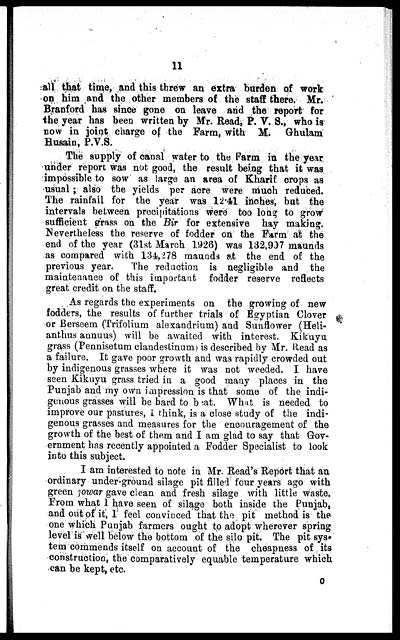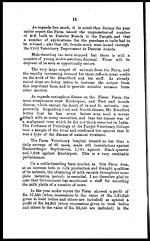Medicine - Veterinary > Civil Veterinary Departments > 1894-1932 - Annual report of the Punjab Veterinary College and of the Civil Veterinary Department, Punjab > 1926-1932 > 1925-1926 - Annual report on the Punjab Veterinary College, the district work of the Civil Veterinary Department, Punjab, and the Government cattle farm, Hissar, for the year 1925-26
(27) Page 11
Download files
Individual page:
Thumbnail gallery: Grid view | List view

11
all that time, and this threw an extra burden of work
on him and the other members of the staff there. Mr.
Branford has since gone on leave and the report for
the year has been written by Mr. Read, P. V. S., who is
now in joint charge of the Farm, with M. Ghulam
Husain, P.V.S.
The supply of canal water to the Farm in the year
under report was not good, the result being that it was
impossible to sow as large an area of Kharif crops as
usual; also the yields per acre were much reduced.
The rainfall for the year was 12.41 inches, but the
intervals between precipitations were too long to grow
sufficient grass on the Bir for extensive hay making.
Nevertheless the reserve of fodder on the Farm at the
end of the year (31st March 1926) was 132,997 maunds
as compared with 134,278 maunds at the end of the
previous year. The reduction is negligible and the
maintenance of this important fodder reserve reflects
great credit on the staff.
As regards the experiments on the growing of new
fodders, the results of further trials of Egyptian Clover
or Berseem (Trifolium alexandrium) and Sunflower (Heli-
anthus annus) will be awaited with interest. Kikuyu
grass (Pennisetum elandestinum is described by Mr. Read as
a failure. It gave poor growth and was rapidly crowded out
by indigenous grasses where it was not weeded. I have
seen Kikuyu grass tried in a good many places in the
Punjab and my own impression is that some of the indi-
genous grasses will be bard to beat. What is needed to
improve our pastures, I think, is a close study of the indi-
genous grasses and measures for the encouragement of the
growth of the best of them and I am glad to say that Gov-
ernment has recently appointed a Fodder Specialist to look
into this subject.
I am interested to note in Mr. Read's Report that an
ordinary under-ground silage pit filled four years ago with
green jowar gave clean and fresh silage with little waste.
From what I have seen of silage both inside the Punjab,
and out of it, 1 feel convinced that the pit method is the
one which Punjab farmers ought to adopt wherever spring
level is well below the bottom of the silo pit. The pit sys-
tem commends itself on account of the cheapness of its
construction, the comparatively equable temperature which
can be kept, etc.
O
Set display mode to: Large image | Zoom image | Transcription
Images and transcriptions on this page, including medium image downloads, may be used under the Creative Commons Attribution 4.0 International Licence unless otherwise stated. ![]()
| Permanent URL | https://digital.nls.uk/75537172 |
|---|
| Additional NLS resources: |
|---|




